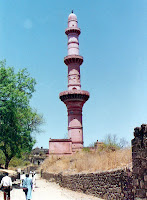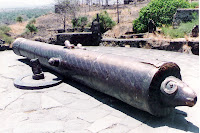
What is there to see in a small non-descript place like Aurangabad?
You must visit the place to find out.
Two Mughal Emperors visited the region, and they liked it so much that they shifted their capital from Delhi to this region.
The Daulatabad Fort, which is one of the world’s best preserved forts of medieval times, alone would make Aurangabad a great place to visit.
But there is far more to see.
Because Aurangabad is also the gateway to the world famous rock cut caves of Ajanta and Ellora.
Aurangabad or Daulatabad
The two terms are indiscriminately used, as if they represent the same place.
But Aurangabad and Daulatabad are two different cities.
Of the two cities, Daulatabad is far older and at a distance of 16 km. from Aurangabad.
Today, the ruins of Daulabad remain just a reminder of its glorious past, while Aurangabad is one of the major cities of Maharashtra with a number of industries.
Daulatabad (old Devagiri)
The ancient city of Devagiri (from deva giri - meaning Hill of the Gods), the old name for Daulatabad, was founded in 1187 by Bhillama V, a king who renounced his allegiance to the Chalukyas, and established the Yadava dynasty in the west.
He also built a fort in Devagiri.
The present Devagiri Fort was constructed later - during the reign of Singhana II (1210 - 46 A.D.).
Devagiri was captured by Ala-ud-Din Khilji in 1307 A.D., marking the first Muslim invasion of the Deccan (South India).
In 1318 A.D., Malik Kafur killed the last Yadava Raja, Harapal.
Because of its strategic location, in 1327 A.D., Muhammed-bin-Tughluq decided to shift his capital from Delhi to Devagiri.
He changed the name of Devagiri to Daulatabad (from daulat bad meaning City of Fortune); and ordered his entire army, the royal household, ministers, advisors, scholars, poets, musicians and others to move from Delhi to Daulatabad.
The people of Delhi did not want to move out to a new place. Muhammed-bin-Tughluq was very angry and ordered everyone including cats and dogs to move.
Within two years, Muhammad decided to return back to Delhi and ordered a return march which very few survived.
Within two years, Muhammad decided to return back to Delhi and ordered a return march which very few survived.
The colossal loss in terms of number of lives lost and the money wasted reduced the prosperity and grandeur of Delhi.
In 1607, Daulatabad passed into the hands of the Nizam Shahi minister, Malik Amber, a usurper, originally an Abyssinian slave, who founded Kharki (the present Aurangabad).
His successors held Daulatabad until their over throw by Shah Jahan, the Mughal emperor, in 1633.
Daulatabad remained in the possession of the Delhi emperors until the death of Aurangzeb, the sixth and last Mughal Emperor.
Therafter, it fell to the first Nizam of Hyderabad.
However, the glory of Daulatabad started declining after the 17th century when Mughal Emperors shifted the seat of government to Aurangabad.
Daulatabad Fort
The Fort is strategically located on a pyramid shaped hill, 600 ft above the Deccan plain.
The Fort was constructed on the remains of a Buddhist monastery and signifies unique military engineering planning skills.
The main features of this Fort are:
· A thick outer wall, 6 kms in circumference, which encircled the entire city of Devagiri, including the magnificent Devagiri Fort. This provided the first line of defense.
· Three concentric lines of massive walls with large number of bastions which provided unparalleled defense fortifications.
· The lower slopes of the hill were sliced away by the Yadava rulers to carve out a 50 meter vertical drop so that no hostile troops could clamber up.
· The walls are surrounded by a 40 ft. deep moat. The moat was filled with water and had a large number of crocodiles. There were mechanical draw bridges.
· Long sub-terranean passages hewn out of solid rock.
· The inner walls had heavy iron gates fitted with large iron spikes to deter the use of elephants for ramming the gates open.
· The upper exit of the passage was filled with an iron grating, on which a large fires could be lighted to prevent the progress of the enemy.
· The summit could be reached only by a narrow bridge, which was wide enough for two persons only.
The impregnable Fort could never be conquered in a straight battle. It was always taken over through deceit and treachery.
The chief of them are the Chand Minar and Chini Mahal.
The Chand Minar was erected in 1445 by Ala-ud-din Bahmani to commemorate his capture of the Fort.
It is a tower 210 ft. high and 70 ft. in circumference at the base.
It was originally covered with beautiful Persian glazed tiles.
It reminds one of the Kutub Minar in Delhi.
Opposite the Minar is the Jumma Masjid (Friday Mosque), whose pillars originally belonged to a temple.
Close by is a large masonry tank.
The Chini Mahal, or China Palace, is the ruin of a very beautiful building.
Abul Hasan, the last Qutb Shahi king of Golconda, was imprisoned by Aurangzeb in this building in 1687.
Nearby is a round bastion topped with a huge canon with a ram’s head, called Kila Shikan or Fort Vanquisher
Aurangabad
Malik Ambar, the Prime Minister of Murtaza Nizam Shah II, of Ahmednagar, the then ruler of the Deccan founded Aurangabad between 1604 and 1610.
Before that, the site was a village called Kirki (or Khadki).
Initially, the city was named Fatehpura (from fateh pur meaning City of Victory), or after Malik’s son Fateh Khan.
In 1634, Aurangzeb came to Kirki as Governor of Deccan.
Ten years later, Aurangzeb moved over to Agra to play a more active role in Mughal politics.
In 1681, the city again became the residence of Aurangzeb, who had now become the Mughal Emperor.
Aurangzeb shifted the capital from Delhi to Aurangabad.
Till his death in 1707 AD, Aurangzeb used the city as a base for his campaigns against the southern kingdoms.
Fatehpura was renamed Aurangabad, after Aurangzeb, sometime during this time.
Aurangzeb lies buried in Khuldabad, a small town near Aurangabad.
Bibi ka Maqbara
The Bibi ka Maqbara was built by Emperor Aurangzeb’s son Azam Shah in 1678, in memory of his mother, Begum Rabia Durani.
Mahal of Agra.
Panchakki
The Panchakki, or water mill, was built by Malik Ambar in 1695.
Water, channeled from a spring in a distant hill, was used to power the mill to grind grain for the pilgrims.
Darwazas
There are four main darwazas (or gates) leading into the city and nine secondary darwazas which formed part of the defense system of Aurangabad.
Aurangabad Caves
Aurangabad has a group of 10 beautiful Buddhist caves just outside the city.
These caves are artificial in the sense they are not natural but were dug out of the soft rock during the 6th and 7th century.
These caves are found on two separate locations, called Western Group Caves (Caves 1 to 5) and Eastern Group Caves (Caves 6 to10) about 1km from each other.
Cave 6 of the Eastern Group has well preserved sculptures of women, with exotic hairstyles and ornamentation.
Cave 7 is the most interesting of the Aurangabad caves.
There are sculptures of scantily dressed women with ornaments and jewels.
Khuldabad
Khuldabad (or the Abode of Eternity) is just a few kilometers from Daulatabad.
In the 14th century, several Sufi saints of the Chishti order, settled down here.
The dargah, or tomb of Moinuddin Chishti, the spiritual guru of the Mughal emperor, Aurangzeb, is in this sacred complex.
Emperor Aurangzeb lies buried nearby in a simple grave as he had wished during his lifetime. His tombstone bears the inscription: “No marble sheets should shield me from the sky as I lie there one with the earth.”
Getting there
Air
Aurangabad has an airport 10 kms from the town.
There are direct flights connecting Aurangabad with Mumbai, Delhi and other Indian cities.
Rail
Aurangabad is well connected to Delhi, Mumbai and other cities.
Road
Aurangabad is about 375 kms from Mumbai.
My Recommendation
Make a full week program and visit Aurangabad, Dalulatabad, Ajanta and Ellora in a single trip. The world famous caves of Ajanta and Ellora are World Heritage Sites.
The summers are hot.
Therefore, the best time to visit these places is between September to early March.







No comments:
Post a Comment